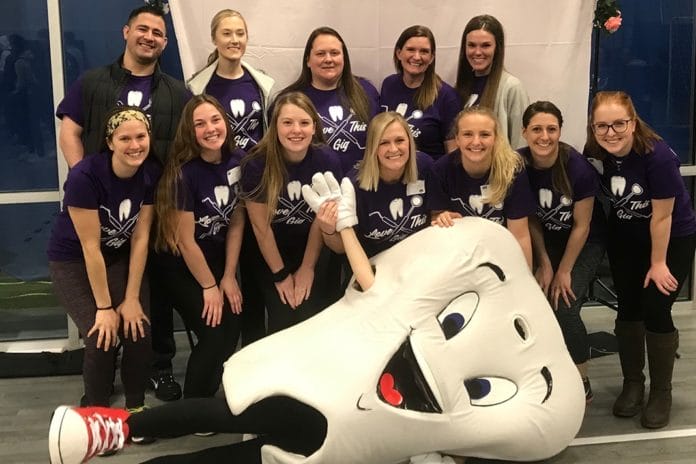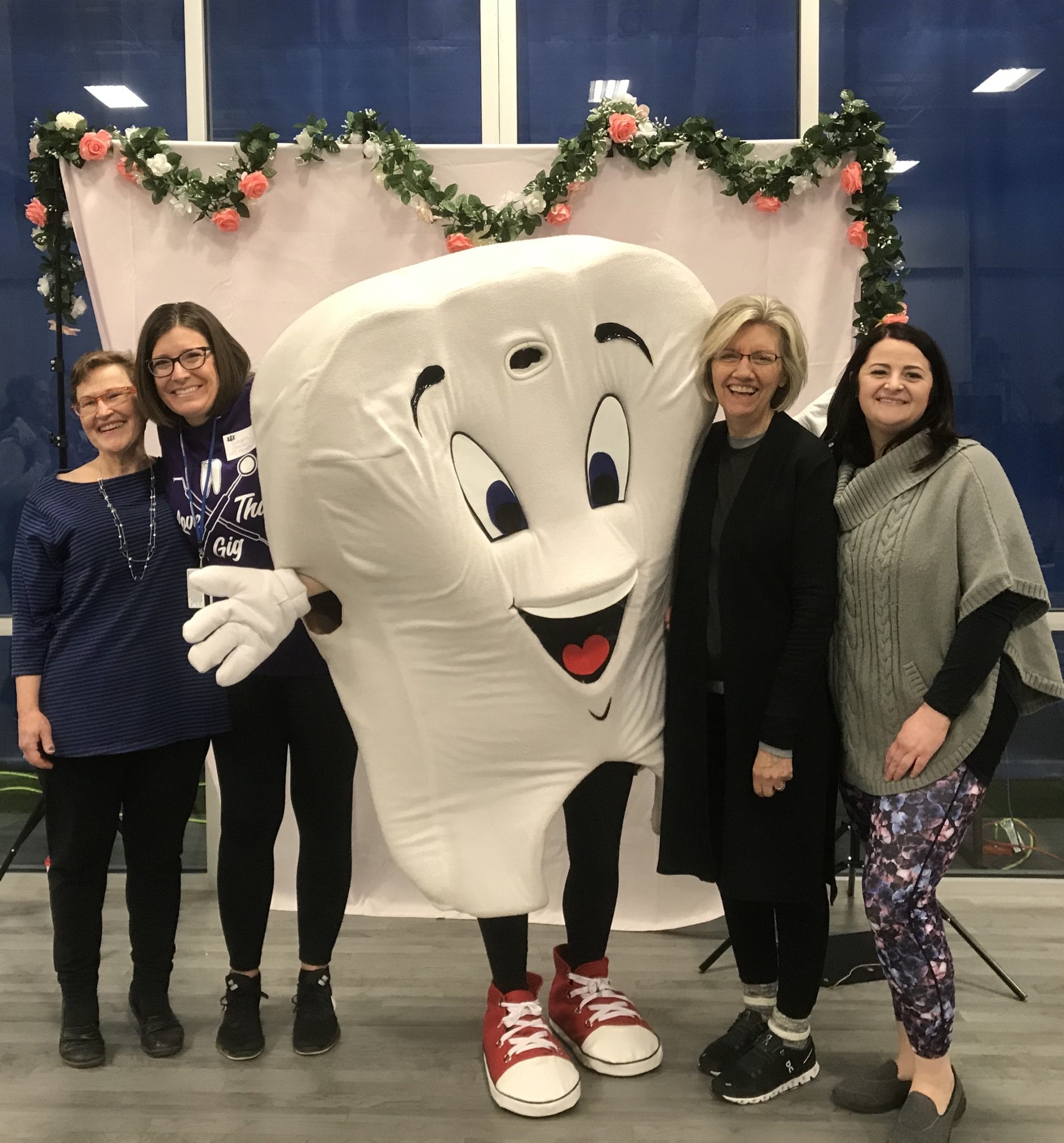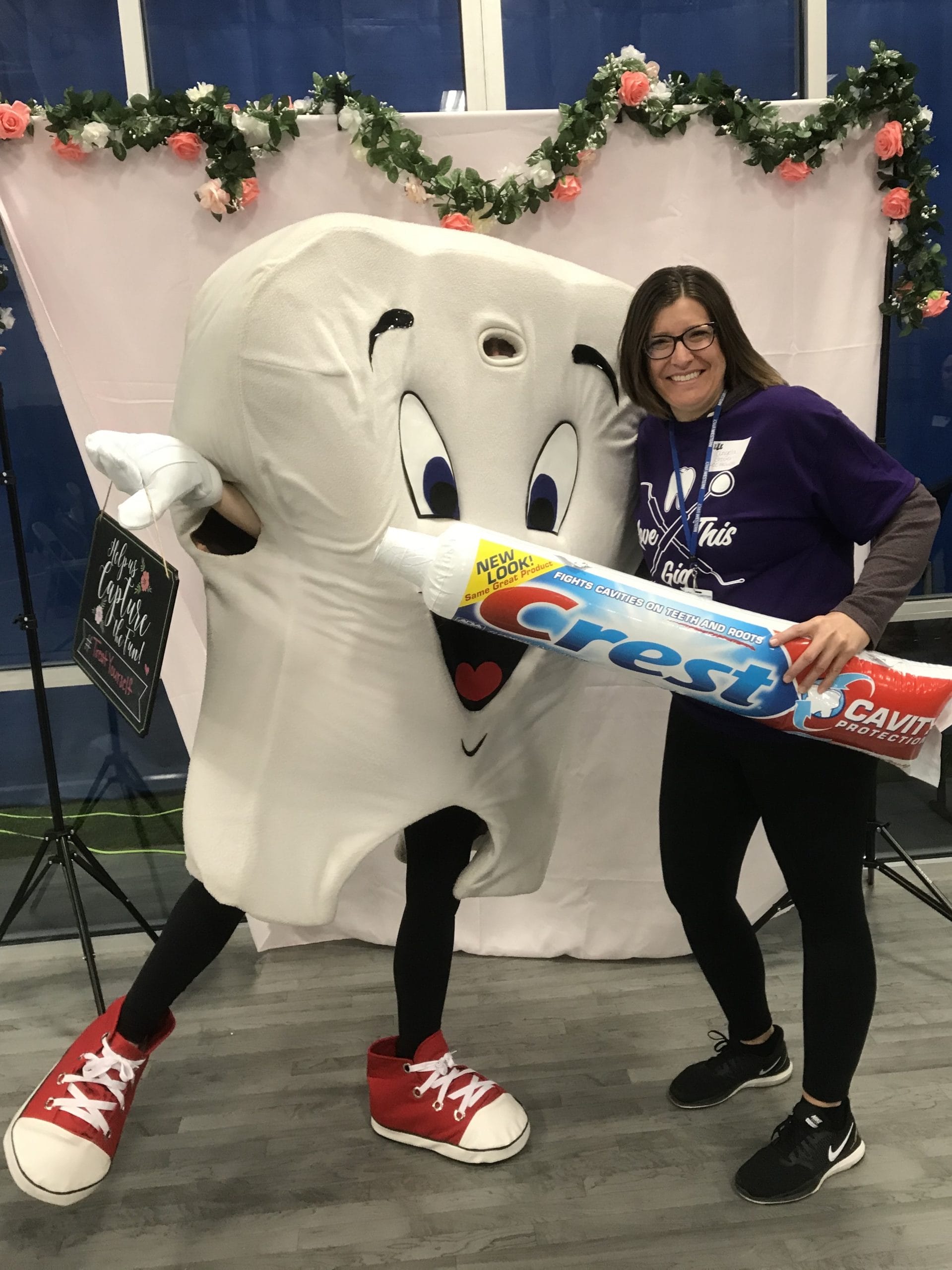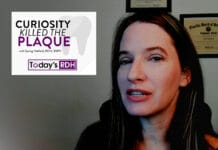
When approached by my dean during the fall 2019 semester about participating in a pilot project through Iowa Campus Compact, an Americorp project that focuses on catalyzing transformation through higher education, people and communities through partnerships, and Iowa Western Community College (IWCC), it was a no-brainer that I would say yes. I love community service projects, and I happen to teach community dentistry and community oral health for the dental hygiene program at IWCC. I attended a training hosted by Iowa Campus Compact and was set loose to come up with a game plan for developing a program that would benefit an organization in the greater Omaha/Council Bluffs area.
I recently had a vision about designing a continuing education (CE) course that focused on hygienists caring for themselves in their careers. I wanted to spoil hygienists since they are always putting everyone else first — their offices and patients, all while juggling the demands of life.
That vision is how “Love This Gig, #treatyourself” was born. I brought the idea to the students, explained my thoughts, and we brainstormed on how we could accomplish this using the dental hygiene process of care for designing a program. We worked through Assessment, Dental Hygiene Diagnosis, Planning, Implementation, and Evaluation (ADPIE) to develop a successful plan.
We decided to partner with the Omaha Dental Hygienists’ Association (ODHA) to pull the event off on February 15, 2020. Who better to serve than our own community of dental professionals? It was also right around Valentine’s Day, which made it ideal to speak to members of the dental hygiene profession about “loving themselves!”
Assessment
During the assessment phase, my student worker, Lindsey Stancil, and I met with the president of the Nebraska Dental Hygienists’ Association (NDHA), Kat Galvan, to pick her brain about the needs of ODHA. Areas that tend to need attention are membership and leadership. It was decided that we would incorporate information about membership and leadership to generate interest in these areas amongst attendees.
We also discussed content for the CE. I had met a former hygienist who now teaches yoga at an ODHA event. I had been in contact with her planning for volunteering to teach at this event. A student had contact with an essential oils teacher. We also wanted to incorporate a massage therapist into the program.
Kat informed us that we could approach this unconventional type of CE, but we had to develop objectives and programming that would place emphasis on how this would be helpful to dental hygiene, aka “ergonomic.” We wanted this course to meet the approval of the Nebraska Dental Board for continuing education credits. We could do that! After all, I am a stickler with my students on ergonomics.
Dental Hygiene Diagnosis
Lindsey and I took this information back to the Community Dentistry class, and the class developed our diagnosis: highlighting ADHA membership and leadership while serving the local dental hygiene community with a CE they could incorporate into their everyday lives. The course would emphasize easy yoga stretches to focus on trouble spots created by inadequate ergonomics, essential oils for hygienists and patients, as well as learning muscles and tendons associated with musculoskeletal disorders (MSD) that may need professional massage.
Planning
Once the objectives were developed, we were able to begin the planning portion for the event. It was vital for the students to see how much time and effort it took 14 of us to successfully pull this off. During fall and spring semester of their final year of school, they use ADPIE for their own community project. Using this pilot project as a guideline, therefore, outlined to them the high level of planning that will be required for their own projects.
Through this event, we broke the class into various committees: registration, membership, leadership, marketing, raffles, and concierges for each speaker. Along the way, it was determined that we would wear purple T-shirts (dental hygiene’s color), which fell under marketing. Refreshments were also determined to be a need, so students stepped up from other committees to make this happen.
Registration was responsible for designing a “passport” for attendees to get initialed at various booths, as well as for each mini-breakout session with the speakers. They also developed a survey to gather information about each attendee regarding ADHA membership.
While many attendees were members of the local dental hygiene association, some were not, which opened up the opportunity to educate these attendees about membership benefits. Therefore, membership designed a takeaway card that outlined how to access registration for ADHA membership, as well as gaining access to the ADHA website to gather more information about the association and its tremendous benefits to members.
Leadership made a brochure that listed leadership roles and the level of commitment that would be needed for each role.
Marketing designed the T-shirt that would be worn by the dental hygiene students working the event and a Facebook page that had the registration link, which encouraged any member to bring a friend! It likewise invited nonmembers to join in on the fun! The Facebook page was also the place where pictures with our tooth mascot could be posted on the day of the event with the #treatyourself.

The raffle committee sought donations for prizes at the end of the CE. On the day of the event, they handed out tickets to attendees based on the number of initials they received on their passport, including signatures for taking a picture with our beloved tooth!
Concierges were assigned to a speaker they would accompany throughout the morning. Their role was to communicate and plan with the speaker for the event, read the bio for their speaker, have the speaking area prepared, and be attentive to the speaker’s needs.
Lindsey and I worked on securing the venue on campus for the event, as well as requesting chairs and tables to be used. I took on the role of obtaining printing materials for the event. In addition, I communicated with a vendor from Young Dental that wanted to have a booth and donate instruments for the raffle.
Implementation
After much planning, we welcomed the day of the event. Early in the morning on February 15, 2020, the first- and second-year hygiene students arrived to set up, including chairs for the opening session, signage on the college campus, stuffing swag bags for attendees, setting up various tables and booths and, of course, our photo area for the toothy grins!

Each committee was assigned first-year students to shadow and step into roles as needed. Lindsey and I had roles that mimicked a project manager, directing each student to where they needed to be during a morning huddle situation. Along the way, we recognized areas that may need more attention. At that point, we utilized our first-year volunteers as we saw fit.
Before attendees arrived, I gave a speech to my students on the expectations I had for those in attendance. I informed the students that this day was about pampering our guests; those who are in the weeds of dentistry every single day, putting a smile on their faces through the good, bad and ugly; these guests deserved this treatment and so much more! This day was simply about encouraging dental personnel to take care of themselves. Anything we could do to make them feel special and cared for was vitally important. The students showed up and followed through on this mission quite well.
As attendees arrived, they were greeted by the registration table, who explained the flow of the day. After receiving the materials needed for the event, participants visited the membership and leadership tables, took pictures with our tooth mascot, and enjoyed refreshments.
Kat Galvan, NDHA president, kicked off the event, followed by a brief overview given by me on the how and why this event was born. Various students presented material on ADHA membership and leadership. Lindsey followed that up with an explanation of what to expect for the morning, which then sent everyone off to their groups.
Each speaker had their own space − yoga in an auxiliary gym, and the massage and essential oils programs in classrooms.
During the yoga session, Kim Stabbe, utilized a chair yoga concept to demonstrate effective techniques that can stretch and strengthen troubled areas that attendees deal with regularly. These techniques are those that can easily be used in the dental operatory. She was a wealth of information for guests, and she spent time answering specific questions for guests following her lecture.
As attendees walked toward the classroom areas, it was not too hard to find their way to a wonderful oasis in the essential oil presentation. Carie Schmidt offered suggestions of oils to lower dental anxiety for patients, as well as oils that are stress-reducing for practitioners. She also shared tidbits about oils that can target painful muscular spots that hygienists might encounter. She likewise taught that many oils help with inflammation, which can benefit patients with gingivitis and periodontal disease.
Nine participants in each of the three groups were the lucky recipients of 10-minute massages performed by Omaha School of Massage Therapy students, and their instructor lectured on muscles and tendons that are abused by dental professionals. One huge takeaway from her lecture was understanding that there are many layers of muscles to get through to address problem areas when getting a massage. She also pointed out that oftentimes one area may be hurting, while it manifests from a completely different area where the muscles attach, which means that massage therapists actually have to address areas that may not feel problematic in order to get clients the relief they are needing.
Throughout the morning, I had various attendees approach me with positive comments about the event!
“You knocked this out of the park!”
“The students are doing so great, acting so professional and helpful!”
“This is the best CE I have ever attended!”
Wow! I knew that I wanted this event to be the best these people had ever attended, but I did not expect that kind of feedback. There are so many awesome speakers and CEs in the dental industry; what an honor it was to be measured up to these. I do believe the approach we used was fresh, exciting, and new, which is why we received the feedback we did.
After the three lectures, we gathered back in the gym for raffle prizes donated by Young Dental, Young Living Essential Oils, various local businesses, and Kat Galvan. It was at that time the CE code was given, and the best part of CEs occurred, networking amongst professionals. While this piece was not planned for, I feel it is a vital piece that students need to witness. Looking back, I did not recognize this as a student, but I now know enough to shed some light on this for my students.
Now that the fruits of our labor were in the books, it was time to break it all down, but that does not mean that the “high” the students and I were experiencing was going away anytime soon. We still had more work to do.
Evaluation
During Community Oral Health the next week, we took to the whiteboard and began ruminating through the event and collected areas of what needed improvement and what went well. This step of the dental hygiene process of care can easily be forgotten amid the “high” of the event. However, it truly is a very critical component, as this is where we make decisions for the future of the program. Community programs like sealant programs that depend upon grants for funding use this data gathered when presenting for further funding.
It was fulfilling to see students collaborating with one another to share their thoughts. We have a list of improvements, which should be expected after a CE program’s first run. One noted victory was that one attendee registered to become an ADHA member onsite! To say that I am proud beyond measure would be a massive understatement. These students stepped up to the plate and truly “knocked it out of the park!”
As I reflect on this project from start to finish, I see incredible value in the partnership with our professional organization through this service learning project with Iowa Campus Compact. At the same time, I recognize that my modeling, throughout the process of care, demonstrated to students what to expect for their own programs. As I write, we are two days away from the first community project, “Leap Into 2020 Children’s Dental Health Fair,” on February 29, 2020! Without a doubt, I know these students will find their own successes because they have had tremendous exposure to the dental hygiene process of care through this event. I believe these students are the future of dental hygiene, and as their instructor, I am grateful that I get to walk alongside them, showcasing their talents!










